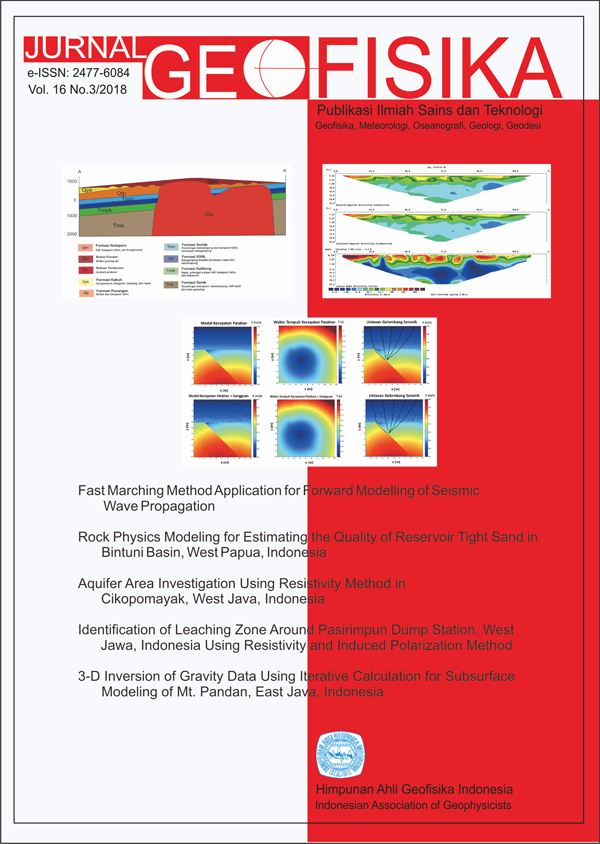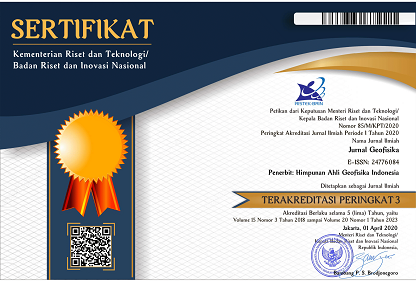Fast Marching Method Aplication for Forward Modelling of Seismic Wave Propagation
Keywords
eikonal equation, Fast Marching Method, seismic wave propagationAbstract
One of the classical problem in seismology is to determine time travel and ray path of seismic wave between
two points at a given heterogeneous media. This problem is expressed by eikonal equation and can be seen as a propagation of a wavefront and interface evolution. One of methods to solve this problem is Fast Marching Method abbreviated as FMM. This method is used to produce entropy-satisfying viscosity solution of eikonal equation. FMM combines viscosity solution of Hamilton-Jacobi equation and Huygen's Principle that centered on min-heap data structure to determine the minimum value at every loop. In this study, FMM is applied to determine time travel and raypath of seismic wave. FMM also is used to determine the location of wave
source using simple algorithm. From our forward modeling schemes, it is found that FMM is an accurate, robust, and effcient method to simulate seismic wave propagation. For further study, FMM also can be used to be a part of passive seismic inverse scheme to locate hypocenter location.
References
LeVeque, R.J., 1992. Numerical Methods for Conservation Laws. Basel: Birkhauser.
Osher, S. dan Sethian, J.A., 1998. Fronts Propagating with Curvature Dependent Speed: Algorithms Based on Hamiltonian-Jacobi Formulations. Journal of Computational Physics, 79, pp. 12-49.
Rawlinson, Nick, 2008. Seismology. Canberra: Australian National University.
Rawlinson, Nick., 2005. The Fast Marching Method: An Effective Tool for Tomographic Imaging and Tracking Multiple Phases in Complex Layered Media. Exploration Geophysics, 36, pp.341-350.
Rawlinson, N and Sambridge, M., 2004. Wavefront evolution in strongly heterogeneous layered media using the fast marching method. Geophys. J. Int. 156, 631{647 doi: 10.1111/j.1365-246X.2004.02153.x
Rawlinson, N and Sambridge, M., 2005. The fast marching method: an effective tool for tomographic imaging and tracking multiple phases in complex layered media. Exploration Geophysics, 36, 341-350
Rouy, E. dan Tourin, A. A, 1992. Viscosity Solutions Approach to Shape-From-Shading. SIAM J. Num. Anal, 29, 3, pp. 867-884.
Sethian, J.A., 1996 A Fast Marching Level Set Method for Monotonically Advancing Fronts. Proc. Nat. Acad. Sci., 93, 4, pp.1591-1595
Sethian, J.A., 2005. Level Set Methods and Fast Marching Methods: Evolving Interfaces in Computational Geometry, Fluid Mechanics, Computer Vision, and Material Sciences. Cambridge: Cambridge University Press.
Sethian, J.A. and Popovici, A.M.,1999. 3-D travel time computation using the fast marching method, Geophysics 64, 516-523.
Sod, G.A., 1985 Numerical Methods in Fluid Dynamics. Cambridge: Cambridge University Press.

This work is licensed under a Creative Commons Attribution 4.0 International License.
The copyright of all articles belongs to the authors. All other copyrights is held by the Journal











